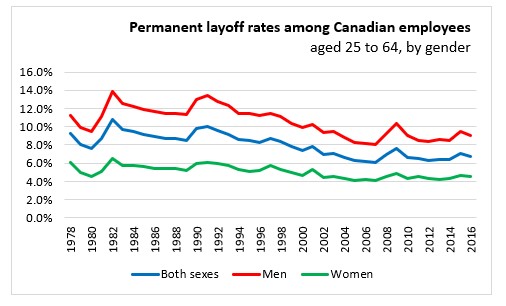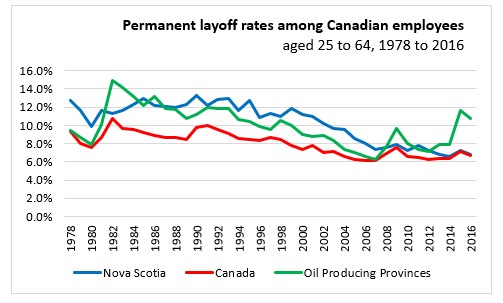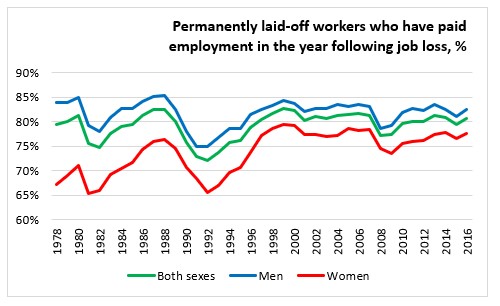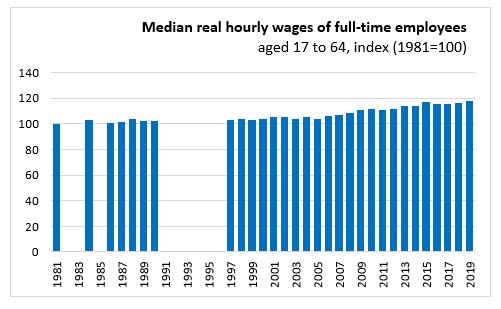The Economics and Statistics Division maintains archives of previous publications for accountability purposes, but makes no updates to keep these documents current with the latest data revisions from Statistics Canada. As a result, information in older documents may not be accurate. Please exercise caution when referring to older documents. For the latest information and historical data, please contact the individual listed to the right.
<--- Return to Archive
For additional information relating to this article, please contact:
June 23, 2020JOB DISPLACEMENT AND JOB TYPES OVER THE LAST FOUR DECADES Today, Statistics Canada released two studies that provided insight on several labour market developments experienced in the Canadian labour market over the last four decades.
The first research article, titled "Permanent Layoff Rates in Canada, 1978 to 2016," analyzes the evolution of permanent layoff rates in Canada from 1978 to 2016, the last year for which data on permanent layoffs are currently available. The second research article, titled "The Changing Job Landscape, 1981 to 2019," shows how several job characteristics—such as real hourly wages, pension plan coverage, unionization, and the permanent or temporary nature of a job—have evolved since the early 1980s.
Technological advancements since the late 1970s have changed the composition of labour demand across different segments of the economy. Computer-based technologies and automation of some work functions reduced the demand for some occupations while creating new occupations such as software developers and application developers. In 2019, roughly 1 in 10 Canadian employees aged 17 to 64 was employed in manufacturing, down from about 1 in 5 in 1981. In contrast, proportionally more paid workers were employed in professional, scientific and technical services, as well as in education, health care and social assistance, in 2019 compared with 1981.
New forms of employment such as temporary jobs and gig economy have also emerged. A recent Statistics Canada study (Jeon, Lu and Ostrovsky 2019) shows that the percentage of workers—employees and self-employed individuals—involved in gig work increased from 5.5 per cent in 2005 to 8.2 per cent in 2016. This increase was observed for men and women and was driven by growth in the percentage of both workers who had only gig employment income and workers who combined gig work and wages and salaries.
The likelihood of Canadian workers losing their job has not increased from 1978 to 2016 despite the changes in the economic environment. The rate of permanent layoffs among employees aged 25 to 64 averaged 6.6 per cent from 2010 to 2016, about one and a half percentage points lower than the 8.3 per cent average from 1978 to 1980.

In 2007—prior to the last recession—layoff rates were more than 2 percentage points lower than in 1989, the peak of the economic expansion that occurred during the second half of the 1980s. Although layoff rates increased from 2007 to 2009, as soon as 2010, they reached lower levels than those observed during the late 1970s or the second half of the 1980s.

In Nova Scotia, layoff rates averaged 7.1 per cent between 2010 and 2016. While there has been ups and downs, Nova Scotia’s layoff rate among workers aged 25 to 64 has been trending downwards.
Although layoff rates in the oil-producing provinces of Alberta, Saskatchewan, and Newfoundland and Labrador rose sharply in 2015 and 2016 following declines in oil prices, layoff rates in other provinces were stable from 2010 to 2016.
While permanent layoff rates did not trend upward, short-term re-employment rates—the percentage of permanently laid-off workers who found new paid jobs in the year following job loss—followed different trajectories for men and women.

As women increased their labour market participation, the percentage of permanently laid-off women who had paid employment in the year following job loss grew over time, reaching 78 per cent in 2016, up from 67 per cent in 1978. In contrast, the percentage of displaced men who were re-employed in the year following job loss hovered around 80 per cent and displayed cyclical fluctuations but no clear trend.
Although, overall, job displacement has not become more frequent and post-displacement employment and earnings outcomes have not worsened from 1978 to 2016, long-tenure displaced workers—who have been with their employer for six years or more—experienced significant and persistent earnings losses.
Over the 1995-to-2015 period, between 53 per cent and 87 per cent of the permanent layoffs in the commercial sector occurred in non-mass layoffs.

From 1981 to 2019, median real hourly wages in full-time jobs increased by 18 per cent, with most of the growth occurring after 2005. The median real hourly wages for women in full-time jobs increased 30 per cent from 1981 to 2019, more than three times than the 9 per cent growth rate observed for men. However, the median hourly rate for women was still lower than men in 2019.
The pay rates changed differently for young and older employees. The median real hourly wages of men aged 25 to 34 employed full time were almost the same in 1981 and 2019, but those of men aged 35 to 54 grew by 13 per cent during that period. The median real hourly wages of women aged 35 to 54 increased by 38 per cent from 1981 to 2019, almost twice the 20 per cent increase observed among young women.
While wages grew moderately, pension plan coverage fell. From 1981 to 2017—the most recent year for which data on pension plan coverage are available—the percentage of employees with a registered pension plan (RPP) fell by 8 percentage points, dropping from 45 per cent in 1981 to 37 per cent in 2017.
The percentage of men with an RPP declined from 51 per cent in 1981 to 35 per cent in 2017 while women’s RPP coverage increased from 35 per cent to 39 per cent over the same period.
While it is too early to know whether COVID-19 pandemic will change these long-term trends, there has been some recent changes since the beginning of the pandemic. Recent data shows that employment losses since February 2020 have been more pronounced in temporary jobs and non-unionized jobs. As a result, the percentage of employees in full-time permanent jobs and in unionized jobs increased from May 2019 to May 2020.
In May 2020, 81 per cent of employees aged 17 to 64 held full-time permanent jobs, up from 76 per cent in May 2019. The proportion of employees in unionized jobs increased from 29 per cent to 31 per cent during the same period.
Median real hourly wages in full-time jobs increased by roughly 11 per cent from May 2019 to May 2020 and average real hourly wages grew by about 9 per cent. About half of the growth in average wages can be accounted for by recent changes in employment away from temporary jobs, non-unionized jobs, and industries and occupations that pay relatively low wages.
Sources: Statistics Canada, Study: Job displacement and job types over the last four decades; Permanent Layoff Rates in Canada, 1978 to 2016; The Changing Job Landscape, 1981 to 2019
<--- Return to Archive